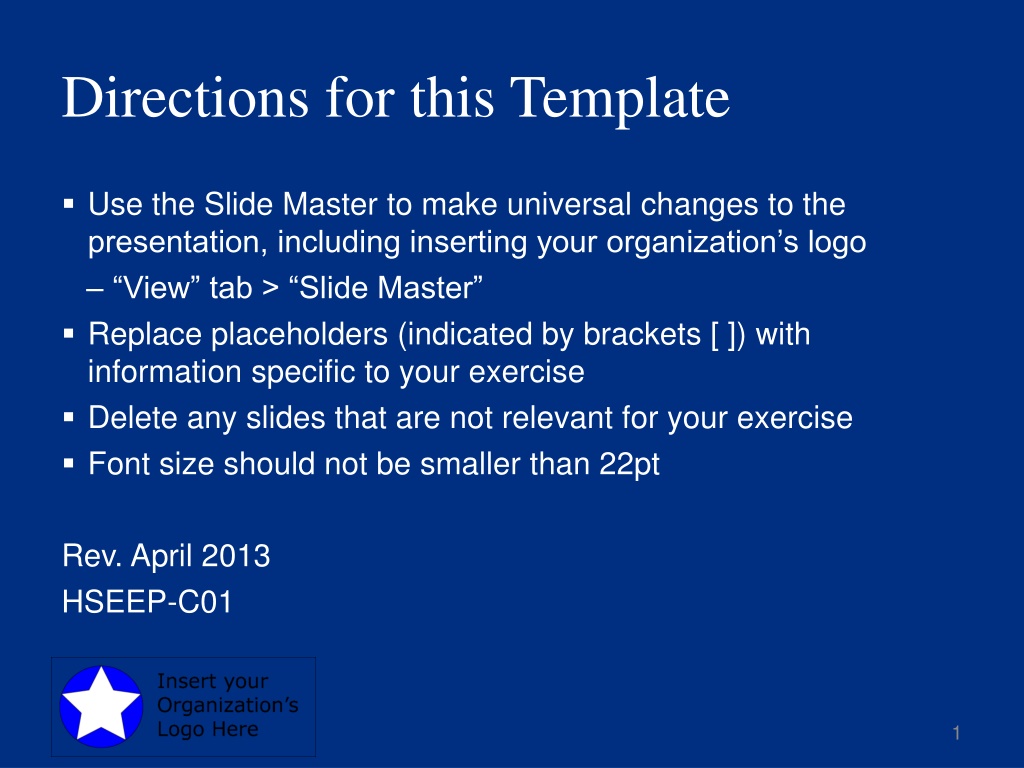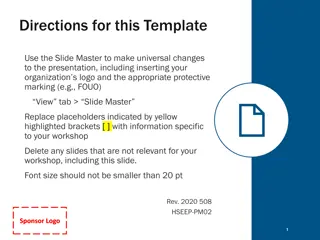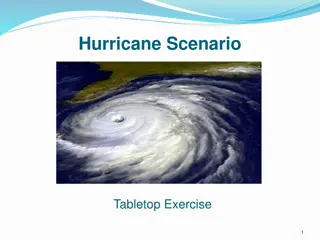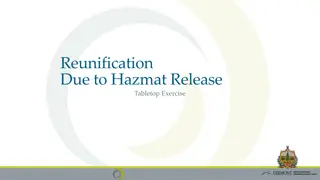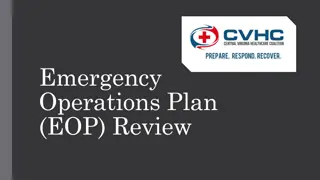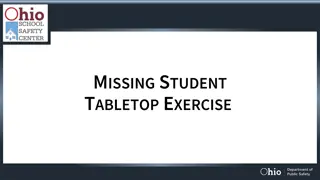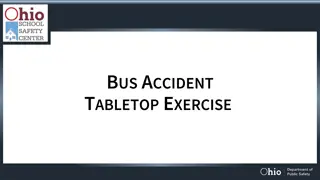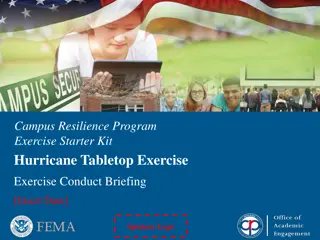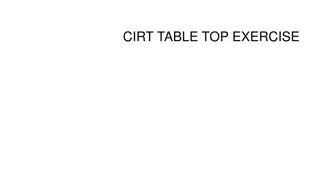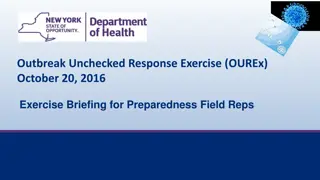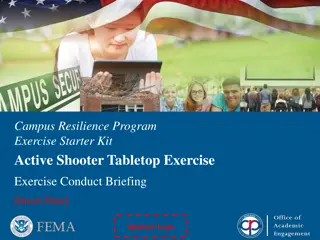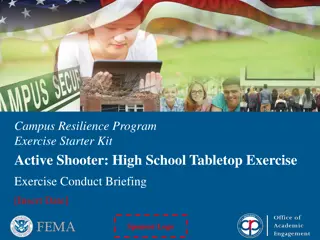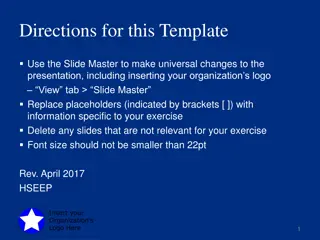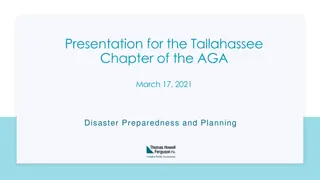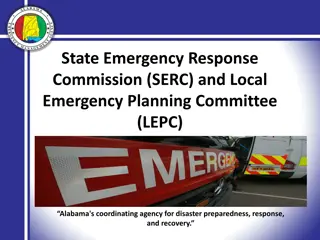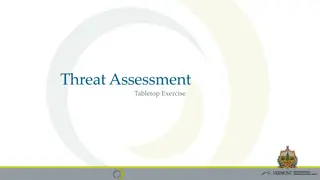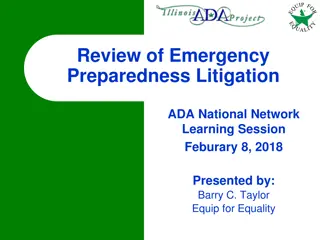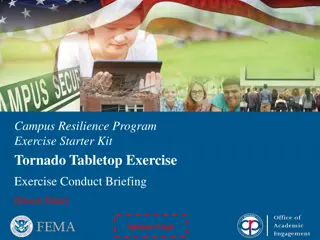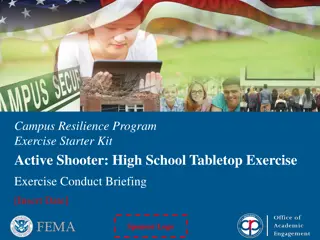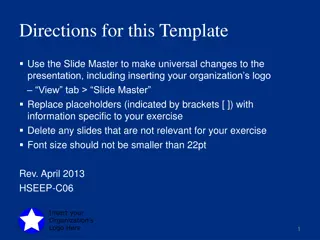Emergency Preparedness Exercise Briefing
In this presentation, you will learn how to conduct an effective emergency preparedness exercise by following a detailed briefing agenda. The slides cover key aspects such as welcome and introductions, meeting agenda items, exercise overview, objectives, scenario description, participants' roles, artificialities, and play restrictions. Utilize the provided template to customize the content to suit your organization's needs and ensure a successful exercise.
- Emergency Preparedness Exercise
- Briefing Agenda
- Participants Roles
- Scenario Description
- Preparedness Training
Download Presentation

Please find below an Image/Link to download the presentation.
The content on the website is provided AS IS for your information and personal use only. It may not be sold, licensed, or shared on other websites without obtaining consent from the author. Download presentation by click this link. If you encounter any issues during the download, it is possible that the publisher has removed the file from their server.
E N D
Presentation Transcript
Directions for this Template Use the Slide Master to make universal changes to the presentation, including inserting your organization s logo View tab > Slide Master Replace placeholders (indicated by brackets [ ]) with information specific to your exercise Delete any slides that are not relevant for your exercise Font size should not be smaller than 22pt Rev. April 2013 HSEEP-C01 1
[Exercise Name] Controller/Evaluator Briefing [Date]
Welcome and Introductions Name Organization 3
Meeting Agenda [Time] [Meeting agenda item] 4
Exercise Overview [General description]
Objectives and Core Capabilities [Exercise objective] [Linked core capabilities] [Exercise objective] [Linked core capabilities] [Exercise objective] [Linked core capabilities] 6
Scenario [Scenario description] 7
Exercise Participants [Exercise participants; identify those with limited extent of play (e.g. XXX hospital extent of play is 8 AM to 12 noon)] 8
Exercise Artificialities Artificialities and constraints, such as the exercise assembly area, may detract from realism. Some other artificialities include the following: Exercise communication and coordination will be limited to participating exercise organizations, venues, and the SimCell Only communication methods listed in the Communications Plan will be available for players to use during the exercise Participating agencies may need to balance exercise play with real-world emergencies. Real-world emergencies will take priority [List others, as appropriate] 9
Exercise Play [Start and anticipated end timelines] [Venue sites] [Play will be restricted to the delineated areas surrounding exercise site] 10
Safety Safety is EVERYONE S concern Safety concerns override exercise execution Be aware of your environment and the responders activities Controllers and evaluators must immediately inform the Safety Controller or Senior Controller of safety concerns Actual emergencies will be identified by the phrase [ real- world emergency ] 11
Exercise Schedule Controller/Evaluator briefing: [Date/time] [Date] Participant registration: [Time] Player briefing: [Time] Start of exercise (StartEx): [Time] End of exercise (EndEx): [Time] Hot Wash: Immediately after EndEx [Date] Controller/Evaluator debriefing: [Time] 12
Exercise Location and Area [Maps] 13
Exercise Identification Controllers Evaluators Support staff Players Observers Media Actors [color] badges [color] badges [color] badges [color] badges [color] badges [color] badges [color] badges 14
Exercise Communications The controller/evaluator communications network enables controllers and evaluators to: Report emergencies or safety issues Report major timeline events Acknowledge communication checks for timeline status The primary means of communications will be [communications methods, e.g. radio, cellular phone, etc.] A list of [phone numbers or radio call signs] can be found in the C/E Handbook 15
Player Deployment [For a drill or full-scale exercise, insert deployment information, as appropriate] Emergency equipment located in and dispatched from the exercise assembly area will be released according to Incident Command The deployment timetable is an estimate based on a real-time response to [incident site] The deployment timetable can be found in the C/E Handbook 16
Weapons Policy [Description of weapons policy as needed] 17
Documentation C/E Handbook Exercise Evaluation Guides (EEGs) Communications Plan MSEL Timeline Injects 18
Master Scenario Events List (MSEL) Timeline [High-level MSEL timeline information] 19
Administrative Details [Restroom locations] [Food and water] [Others as necessary] After the Hot Wash, please return: All badges All documentation (EEGs and any notes/logs) Participant feedback form 20
Controller Responsibilities Senior Controller Monitor exercise progress and make decisions regarding any deviations or changes Coordinate any required modifications Controller Introduce, maintain, and coordinate exercise events in accordance with the MSEL Observe and report exercise artificialities that interfere with realism Additional information is listed in the Controller and Evaluator (C/E) Handbook 21
Controller Guidelines DO: Deliver injects promptly as listed in the MSEL or directed by the Senior Controller or Exercise Director Coordinate activities with the Exercise Director, Senior Controller, SimCell, and other controllers in your area Notify the Senior Controller of events or need for changes Notify the Exercise Director and/or Senior Controller of ANY problems related to safety or scenario play Begin and end all exercise communications with the statement, [ This is an exercise ] 22
Controller Guidelines (contd) DO NOT: Hold personal conversations with players Provide extra or advance information to players Prompt players (unless directed by the Exercise Director or Senior Controller) 23
Evaluation Overview The goal of exercise evaluation is to assess an organization s capabilities to accomplish a mission, function, or objective Evaluation is accomplished by: Observing the event and collecting supporting data Analyzing the data to compare performance against expected outcomes Reporting exercise outcomes in the AAR 24
Evaluator Responsibilities Understand the exercise objectives, core capabilities, concept, and scenario Be familiar with the plans, policies, and procedures for the function or organization being evaluated Use EEGs to document performance relative to exercise objectives, core capabilities, capability targets, and critical tasks Inform the Senior Controller of problems related to exercise design Collect and submit all evaluation data, EEGs, and materials to the Lead Evaluator after the exercise Additional information is listed in the C/E Handbook 25
Evaluator Guidelines DO: Observe and record player activities Focus on critical tasks and capability targets Assign EEG capability target ratings Document strengths and areas for improvement Complete your EEGs either during or immediately after the exercise DO NOT: Leave your post at key times Prompt players Answer questions for players Interfere with player actions 26
Evaluation Requirements Evaluation requirements specify what will be evaluated during the exercise and how exercise play will be assessed Evaluation requirements are documented in the EEGs Core capabilities Capability targets Critical tasks Performance ratings 27
Exercise Evaluation Guides EEGs will be used to track evaluation of the objectives The following evaluation requirements have been selected for this exercise: Objective Core Capability [Insert core capability] [Insert core capability] [Insert core capability] Capability Target(s) [Insert target(s)] [Insert target(s)] [Insert target(s)] Critical Task(s) [Insert critical task(s)] [Insert critical task(s)] [Insert critical task(s)] [Insert exercise objective] [Insert exercise objective] [Insert exercise objective] 28
EEGs (contd) 29
EEGs (contd) 30
Capability Target Ratings Evaluators assign ratings for each capability target listed on the EEG Review notes and observations relating to EEG critical tasks, and assign one of four ratings for the capability target: Performed without Challenges (P) Performed with some Challenges (S) Performed with Major Challenges (M) Unable to be Performed (U) Consult the ratings definitions page in the EEG to determine the correct rating for the capability target 31
Final Reminders Safety comes first. Use the phrase [ real-world emergency ] when an emergency occurs Know your role and responsibilities Understand the scenario Do not prompt or get in the way of players Contact the Exercise Director and/or Senior Controller with any problems or questions 32
Questions? 33
